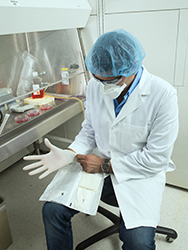Is your glove packaged in a dispenser box? Is it labeled ‘examination glove’ ?
If so, it is not suitable for a critical environment. Why? Boxed exam gloves are designed to protect the operator. Cleanroom Gloves are engineered to both protect the operator and your critical product.
Controlled environment gloves are flat packaged in a critical environment with the cuffs all to one end in two stacks of 50 each, double poly-bagged 100 per pack, 10 packs per case in a carton liner to ensure product integrity. Boxed gloves are not.
Over 98% of thin-wall, powder-free gloves are used in medical / lab / industrial applications. Operators of controlled environments often unknowingly procure a glove not designed to their application. Powder-free lab / industrial / medical grade boxed gloves are not suitable for a controlled environment because:
- Boxed gloves are powder-free, not particulate-free. Uncoated chipboard dispenser boxes shed particles, and contaminate the powder-free gloves.
- Dispenser boxes force operators to contaminate glove when donning. Operators’ bare hand should only make cuff contact.
- Additives and fillers are often used in boxed gloves which reduce ESD compatibility (surface resistivity), and negatively impact glove cleanliness.
- No post-processing to reduce surface contamination left from the dipping process
Engineered to protect your Product, Process & Operator
Valutek’s gloves are packed in double poly bags, vacuum sealed, flat packed in carton boxes and with a carton liner. All gloves are critical environment compatible, lot traceable with retention samples held in quality control for 36 months from date of manufacturing.
Vacuum seal benefit: better storage, no particulate release, no ESD issue
Filed under: Article, Cleanroom products, Contamination Control, Critical Environment | Tagged: boxed, Cleanroom, examination, Gloves, packaging, Valutek | Leave a comment »










